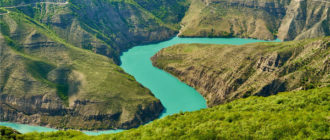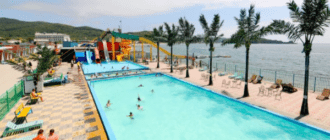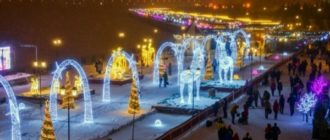Храм василия блаженного на английском
Sacred Destinations
Sacred Sites, Religious Places, Pilgrimages
Russia
- Russia Overview
- Russia Map
- Russia Photos
- Russia Books
- Russia Sacred Sites
- Russia Destinations
- Moscow
- St. Petersburg
Moscow
- Moscow Overview
- Moscow Map
- Moscow Photos
- Moscow Books
- Moscow Sacred Sites
- Andronikov Monastery
- Cathedral of Christ the Savior
- Cathedral of the Annunciation
- Cathedral of the Archangel
- Cathedral of the Assumption
- Choral Synagogue
- Danilov Monastery
- New Jerusalem Monastery
- Novodevichy Convent
- Novospassky Monastery
- St. Basil’s Cathedral
Related Books
- Sacred Destinations
- Destinations
- Russia
- Moscow
- St. Basil’s Cathedral
St. Basil’s Cathedral
The spectacular St. Basil’s Cathedral in Moscow was commissioned by Ivan the Terrible in the 16th century to commemorate a military victory. It is easily the most famous sight on Red Square.
History of St. Basil’s Cathedral
St. Basil’s was built to commemorate the capture of the Tatar stronghold of Kazan in 1552, which occured on the Feast of the Intercession of the Virgin. The cathedral was thus officially named Cathedral of the Intercession of the Virgin by the Moat (the moat being one that originally ran beside the Kremlin).
But the cathedral was popularly known as St. Basil’s Cathedral, after St. Basil the Blessed (a.k.a. St. Basil Fool for Christ; 1468-1552), almost from the beginning. Basil impressed Ivan in 1547 when he foretold a fire that swept through Moscow that year. Upon his death, Basil was buried in the Trinity Cathedral that stood on this site at the time.
The Cathedral of the Intercession a.k.a. St. Basil’s Cathedral was constructed from 1555 to 1560. Legend has it that after it was completed, Ivan had the architect blinded in order to prevent him from building a more magnificent building for anyone else. (In fact, he went on to build another cathedral in Vladimir.)
In 1588, Tsar Fyodor Ivanovich added a ninth chapel added on the eastern side to house the grave of St. Basil.
In modern times, St. Basil’s came very close to falling victim to Stalin, who resented that it prevented his soldiers from leaving Red Square en masse. But the architect Baranovsky stood on the cathedral’s steps and threatened to cut his own throat if the masterpiece was destroyed and Stalin relented (but punished Baranovsky with five years in prison).
More recently, St. Basil’s Cathedral has suffered significant damage from weather and neglect. It was not until the Millennium that funds were allocated to restore its foundations and flaking surfaces.
What to See at St. Basil’s Cathedral
Saint Basil’s is located at one end of Red Square, just across from the Spasskaya Tower of the Kremlin. Not particularly large, it consists of nine chapels built on a single foundation.
The riot of color and shapes that is St. Basil’s Cathedral is unmatched anywhere else in the world. The French diplomat Marquis de Custine commented that it combined «the scales of a golden fish, the enamelled skin of a serpent, the changeful hues of the lizard, the glossy rose and azure of the pigeon’s neck» and wondered at «the men who go to worship God in this box of confectionery work.»
The powerfully eastern design of St. Basil’s reflects both its location between Europe and Asia and its historical origins. Since the Kazan Qolsharif mosque had been the principal symbol of the Khanate captured by Ivan the Terrible, some elements from the mosque were incorporated into the cathedral to symbolize the victory.
Although the towers and domes appear chaotic, there is symmetry and symbolism in its design. There are eight domed chapels symbolizing the eight assaults on Kazan: four large and octagonal and four small and square. In the center is a tent-roofed spire topped with a small golden dome.
The ninth chapel on the east side added in 1588 for Basil’s tomb interrupts the symmetery of design somewhat. It can be recognized on the outside by its green-and-gold dome studded with with golden pyramids.
The interior is a maze of galleries winding from chapel to chapel and level to level via narrow stairways and low arches. The walls are painted in floral and geometric patterns.
St. Basil the Blessed can be visited in his chapel on the lower floor, where he lies in a silver casket in gaudy splendor. Upstairs, the Chapel of the Intercession contains the equally splendid blue and gold iconostasis. Other chapels, such as that of St. Nicholas, are more restrained and even austere in their decor.
In a garden at the front of the cathedral stands a bronze statue commemorating Dmitry Pozharsky and Kuzma Minin, who rallied Russia’s volunteer army against the Polish invaders during the Time of Troubles in the late 16th and early 17th centuries.
The statue was originally constructed in the center of Red Square, but the Soviet government felt it obstructed parades and moved the statue in front of the cathedral in 1936.
Quick Facts on St. Basil’s Cathedral
| Site Information | |
| Names: | Cathedral of St. Basil the Blessed · Intercession Cathedral · Pokrovsky Sobor · Sobor Vasiliya Blazhennovo · St. Basil’s Cathedral |
|---|---|
| Country: | Russia |
| Categories: | cathedrals |
| Dedication: | St. Basil |
| Dates: | 1534-61 |
| Visitor and Contact Information | |
| Coordinates: | 55.752550° N, 37.623067° E |
| Address: | Red Square Moscow, Russia |
| Phone: | 095/298-3304 |
| Hours: | 11am-6pm; closed Tues and 1st Mon of each month |
| Lodging: | View hotels near St. Basil’s Cathedral |
Note: This information was accurate when first published and we do our best to keep it updated, but details such as opening hours and prices can change without notice. To avoid disappointment, please check with the site directly before making a special trip.
References
- The Rough Guide to Moscow, 4th ed. (April 2005), 73.
- St. Basil’s Cathedral – Fodor’s Online Travel Guide
- St. Basil’s Cathedral – Moscow-Taxi.com
- St. Basil’s Cathedral – Moscow’s Districts and Landmarks
More Information
- Photos of St. Basil’s Cathedral — here on Sacred Destinations
Map of St. Basil’s Cathedral
Below is a location map and aerial view of St. Basil’s Cathedral. Using the buttons on the left (or the wheel on your mouse), you can zoom in for a closer look, or zoom out to get your bearings. To move around, click and drag the map with your mouse.
- Sacred Sites & Religious Places
- About
- Contact
- Privacy Policy
Sacred Destinations is an online travel guide to sacred sites, religious travel, pilgrimages, holy places, religious history, sacred places, historical religious sites, archaeological sites, religious festivals, sacred sites, spiritual retreats, and spiritual journeys.
Sacred Destinations is an independent editorial publication. It is not the official website of any sacred site or religious building listed here.
Except where indicated otherwise, all content and images © 2005-2021 Sacred Destinations. All rights reserved.
St. Basil’s Cathedral, Moscow
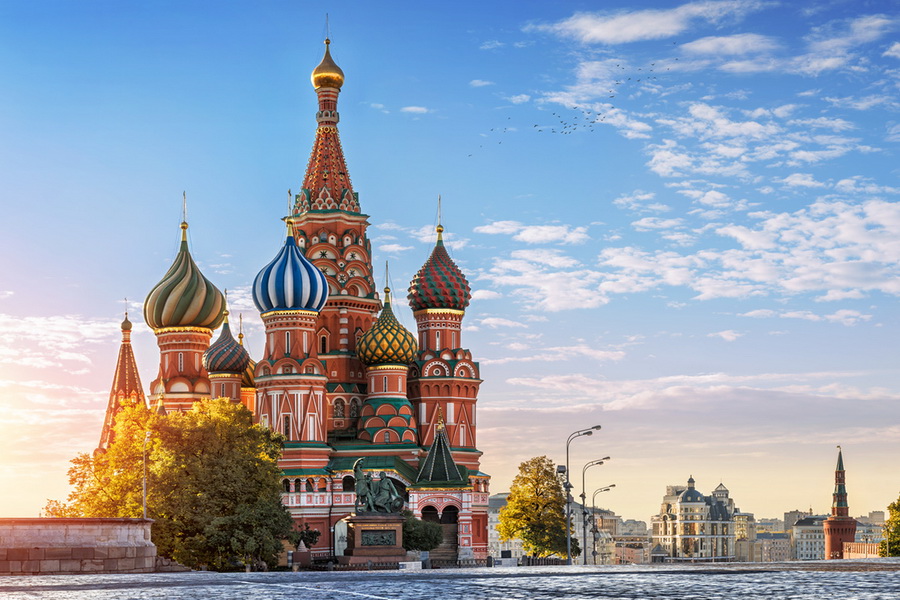
One of Russia’s most recognizable architectural masterpieces is Pokrovsky Cathedral, better known as St. Basil’s Cathedral in Moscow. This Orthodox church, which has earned international recognition for its unique beauty, is located in the historical center of Russia’s capital. Its structural distinctiveness evokes endless admiration from guests and justifiable pride in Muscovites, who are honored to call this world masterpiece their own.
The cathedral was built from 1555-1561 by order of Tsar Ivan the Terrible, who vowed that he would build a church if the city of Kazan were captured from the Kazan Khanate. The people initially called the Cathedral Pokrov na Rvu (Moat Cover) as it was built next to a deep moat that ran along the eastern wall of the Moscow Kremlin.
In one of the cathedral’s chapels lies St. Basil the Blessed, the most revered holy fool in Russia from whom the church received its unofficial name. Legend has it that he collected money for the construction of Pokrovsky Cathedral and was known to throw coins over his right shoulder on Red Square in Moscow, which no one, not even the thieves, dared to touch. In August 1552, shortly before his death, St. Basil gave the collected money to Ivan the Terrible, who ordered a temple be built on the site.
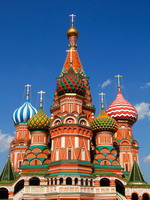
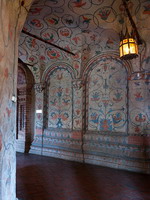
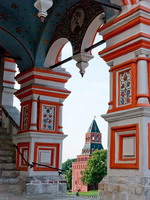
Although the church was built by two Russian architects, Postnik and Barma, their identity only became known in 1895, when records were found in a historical manuscript collection of the 17th century. According to legend, Ivan the Terrible, upon seeing the construction of St. Basil’s Cathedral completed according to the architects’ design, was so delighted with its beauty that he ordered the architects be blinded so that they could never again build a temple equal in splendor to Pokrovsky Cathedral.
At St. Basil’s Cathedral, facts and legends have become enmeshed. According to another legend, Napoleon wished to move this architectural miracle to Paris. As the technology of the time was unable to cope with this task, the French emperor instead ordered his army to blow up the church, along with the Kremlin, before retreating. The Muscovites tried in vain to extinguish the lighted wicks, but providence intervened through a sudden torrential downpour, which helped to dowse the fire and save the church from destruction.
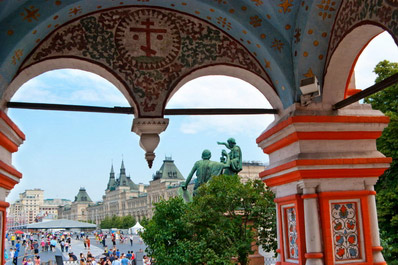
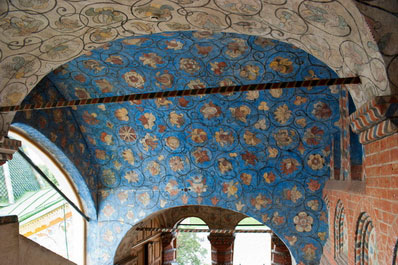
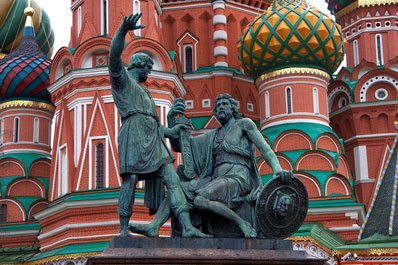
St. Basil’s Cathedral is a symmetrical ensemble of eight colorful, pillar-shaped churches surrounding the ninth and highest chapel, which is crowned with a pergola. Each of the eight churches is named after a saint on whose holy day a significant event of Ivan the Terrible’s Kazan campaigns took place. The central church is dedicated to the Feast of the Intercession of the Mother of God, for it was on this day that Kazan was stormed. The multihued churches are crowned with bulbous domes, each of which is unique in its architectural design. Each dome is further decorated with cornices, arched semi-circles, windows and niches.
St. Basil Cathedral’s interior is equally impressive. In the 1920s, it received the status of a museum, and since 1934 has been listed as a branch of the State Historical Museum. The cathedral-museum has nine iconostases, which contain about 400 icons of the 16th-19th centuries and represent the best examples of Novgorod and Moscow iconography. In addition to icons, the cathedral holds portrait and landscape paintings, church utensils, various weapons from the reign of Ivan the Terrible and an interesting collection of bells cast in Russia, Belarus, Holland, France and Germany. Among the most valuable exhibits is a 17th-century chalice (a liturgical vessel for consecrating wine) that belonged to Tsar Alexey Mikhailovich. The colors and detail of the frescoes splayed across the churches’ interior likewise leave many visitors speechless.
St. Basil’s Cathedral in Moscow attracts millions of tourists each year and has been counted among Russia’s UNESCO World Heritage Sites since 1990.
Английский ( топик ): Moscow: Red Square, the Cathedral of St. Basil and the Kremlin — Москва: Красная площадь, собор Василия Блаженного и Кремль
Moscow: Red Square, the Cathedral of St. Basil and the Kremlin
The most famous sight of the city is Red Square. It has witnessed many important events in the life of the Russian people. In the southern part of Red Square near the Spassky Gates the Cathedral of St. Basil is situated. It is easily distinguished by its coloured cupolas. Centuries of Russian architectural development are represented in Red Square and this remarkable building.
It was built as a monument to a historical Russian victory, as a result of which the Khanates of Kazan and Astrakhan were annexed to Russia in October 1552. It is a masterpiece of Russian architectural art.
Building of St. Basil Cathedral began in 1555 on the orders of Ivan the Terrible and it was completed in 1561.
Not far from the Cathedral of St. Basil there is a monument to Minin and Pozharski, the heroes of the national Uberation struggle against the Polish and Lithuanian invaders in the early XVII century.
This was the first monument in Moscow, erected to civilians
One of the most significant sights of Moscow is the Kremlin.
It is the heart of Moscow and the heart of the whole country. It is the seat of the government and the place where the most significant events are held. It is also the cradle of Moscow.
The Kremlin is the place from where the ancient Russian capital grew and developed and its walls have looked down on the most important events in the history of the old Russian state, the world’s first socialist country, its decline, and the birth of the new Russian state.
There is a great collection of art treasures on the Kremlin territory. The ancient Kremlin is still a great mystery. There is a legend that a considerable part of the treasures lies hidden.
Москва: Красная площадь, собор Василия Блаженного и Кремль
Самая главная достопримечательность города — это Красная площадь. Она была свидетельницей многих важных событий в жизни россиян.
В южной части Красной площади, неподалеку от Спасских ворот, находится собор святого Василия. Его легко узнать по разноцветным куполам. Столетия архитектурного развития России представлены на Красной площади и в этом замечательном строении. Храм был построен в честь исторической победы России, в результате которой в октябре 1552 г. ханства Казани и Астрахани были присоединены к России. Это шедевр русского архитектурного искусства. Строительство собора Василия Блаженного началось в 1555 г. по приказу Ивана Грозного и было закончено в 1561 г.
Неподалеку от собора Василия Блаженного находится памятник Минину и Пожарскому, героям национально-освободительной борьбы России против польских и литовских захватчиков в начале XVII в. Это первый памятник в Москве, воздвигнутый в честь его граждан.
Также одной из самых главных достопримечательностей Москвы является Кремль. Это сердце Москвы и сердце целой страны. Он является резиденцией правительства и местом, где проводятся самые знаменательные события. Также он — колыбель Москвы. Кремль — это место, откуда начала расти и развиваться древняя российская столица, и его стены с высоты смотрели на важнейшие события в истории старого русского государства, первой в мире страны социализма, ее падение, рождение нового российского государства. На территории Кремля находится огромная коллекция бесценных произведений искусства. Древний Кремль все еще представляет собой великую тайну. Есть легенда, что значительная часть сокровищ спрятана в неизвестном месте.
1. What has Red Square witnessed?
2. What is in the southern part of Red Square near the Spassky Gates?
3. What is the Cathedral distinguished by?
4. Why was it built?
5. What was the result of the great historical Russian victory in 1552?
6. When did the building of St. Basil Cathedral begin?
7. Who ordered to build the cathedral?
8. When was it completed?
9. Where is the monument to Minin and Pozharski?
10. Who were these men?
11. Who invaded Russian state in the early XVII century?
12. What is the heart of Moscow and the whole country?
13. Can the Kremlin be called the cradle of Moscow?
14. What is there on the Kremlin territory?
15. Have you heard the legend about hidden treasures?
witness свидетель
the Spassky Gates Спасские ворота
easily легко, без труда, непринужденно
distinguished различимый, узнаваемый; характерный
particoloured пестрый, разноцветный
cupola купол
remarkable замечательный, примечательный
to be annexed to быть присоединенным к
masterpiece шедевр
Ivan the Terrible Иван Грозный
civilian гражданин
whole целый
significant значительный
event событие
to be held проводиться, иметь место
cradle колыбель
to grow (grew, grown) расти
to look down смотреть свысока, презрительно
decline падение, упадок
birth рождение
treasure сокровище
mystery тайна
hidden скрытый, спрятанный от
to hide прятать, скрывать
1. Прослушать произношение слова и перевод на howjsay.com . Направление перевода выберите один раз из списка, в дальнейшем оно сохранится. Для многократного повторения подводите стрелку мышки к выделенному слову в колонке слева.
2. Правила чтения слов смотрите здесь .
Saint Basil’s Cathedral, Moscow
In short
O ne of the visually most surprising buildings in the world is Saint Basil’s Cathedral in Moscow, Russia. This amazing church was built 450 years ago next to the Moscow Kremlin.
Rating
 72.0%
72.0%
GPS coordinates
Location, address
Category
Alternate names
Name in Russian
Year of construction
Architectural style
Branch of Christianity
UNESCO World Heritage status
Map of the site
In detail
History
Ivan the Terrible and his victories
The history of Saint Basil’s Cathedral was started by Ivan the Terrible – the tsar of Russia who reigned in 1533 – 1584. In his time the area governed from Moscow expanded mainly in southern and eastern directions, reaching the Caspian Sea and stepping over the Urals into Western Siberia.
Troops of Ivan the Terrible won many significant victories and one of the most important was the capture of Kazan in 1552.
1552 – 1555: “Churches of triumph”
It has been very important for rulers to mark their achievements and victories in all times and all countries. Ivan the Terrible was not an exception to this.
In the 1550s there was built the first church – Trinity Church, built of white stone and commemorating the capture of Kazan. At the end of the Astrakhan campaign (1556), there were built seven more wooden churches around the Trinity church, next to it. Such churches commemorating military victories were seen as something new, also their planning and the outer look was highly original.
Churches were located outside the walls of Kremlin – what also was something new, seen as a bow towards the populace of Moscow.
St. Basil
The church is named after Basil the Blessed (in Russian – Василий Блаженный, lived in 1469 – 1552) – an eccentric Russian Orthodox saint. He devoted himself to a specific kind of servitude to God – yurodstvo – where the devotee pretends to be a fool and refuses any comforts. Thus Basil the Blessed lived without a permanent residence, walked naked, with chains, and deliberately summoned to humiliations from the cruel crowd (although in general, he was much respected).
Basil the Blessed gained respect through his candid and fair conduct and opinion – and contemporaries considered that he might be the only person truly respected by Ivan the Terrible. He was buried in the site of future St. Basil’s Cathedral.
Saint Basil is not the only “sacred fool” buried here – also Ivan the Blessed was buried on church grounds in 1589.
1555 – 1561: Stone churches are built
In 1555 Ivan the Terrible ordered to rebuild the churches.
There were built new stone churches in the site of Trinity Church and surrounding eight wooden churches – Church of Trinity was consecrated on 12 July 1561.
According to the popular tradition, the architects of this amazing structure were Barma and Postnik Yakovlev.
Now many researchers consider that this was one person, an artisan from Pskov.
Legend tells that Ivan the Terrible ordered to pierce the eyes of the architect so that nothing similar is built elsewhere. Such conduct might be in the style of Ivan the Terrible, but it seems that legend was not correct this time. The name of Postnik appears in connection with some more beautiful Russian churches elsewhere (also Kazan Kremlin), constructed in later times.
1561 – 1683: “Jerusalem Temple”
Saint Basil’s Cathedral was by all accounts a very impressive and very well known building. The central church – Trinity Church, for example, was the tallest structure in Moscow until 1600 when Ivan the Great Bell Tower inside the Kremlin was raised up to its present height – 81 m.
The church gained high importance in the life of the city. The dense group of nine churches resembled a mythical citadel and was called “Jerusalem”. The structure served indeed as an allegory of the Jerusalem Temple in the annual parade, which was attended by the Patriarch of Moscow and the tsar.
As the years passed, the church experienced numerous rebuildings.
In 1588 there was added one more church to the complex – the tenth one.
In 1583 there burned down the Trinity church – it was rebuilt in 1593.
In 1680 – 1683 the former complex of ten churches was united by a ground floor. The newly built galleries were adorned with frescoes – rich floral ornamentation.
1683 – 1918: wars and restoration works
In 1737 the church suffered from a fire.
There were done extensive repairs in 1761 – 1784 when the walls of the first two floors were adorned with frescoes.
The church was looted in 1812 by the French troops. Napoleon wanted to destroy it but happily, it did not happen.
The cathedral was restored back to its former glory in 1816.
More restoration works were carried out in 1896 – 1909.
Outstanding personality was the last keeper of the cathedral from the Orthodox church – Ivan Vostorgov. This socially active, tireless clergyman was executed by Bolsheviks in 1918.
Bolsheviks and museum
Bolsheviks initially were obsessed with an idea to demolish Saint Basil’s Cathedral. In 1933 it was even removed from the heritage register in order to start the demolition, but happily, the mood of Soviet leaders soon changed and the value of the church was recognized. Since then here several times were performed repair works.
During the Soviet times, the cathedral was seized from the Russian Orthodox community and was used as a branch of the State Historical Museum since 1928. It remains the property of the Russian Federation up to this day. Since 1991 there was renewed church service.
In 1957 – 1961 there took place meticulous work to remove the oil layers, painted in the 18th century over the old frescoes. The multiple layers of frescoes pose a challenge to restorers – it is not always clear which one of these is the one to be exposed to.
Nowadays the cathedral is one of the symbols of world architecture, a very popular landmark.
It has been noted though that the building has an adverse impact from another important Russian tradition – the military parades on Red Square. The heavy tanks and jet fighters create cracks in the walls of the cathedral.
The architecture of Saint Basil’s Cathedral
Style and influence
There has been no similar building built before or after. The complexity and amazing mix of details have no analogs in Russian architecture. It has left a huge impact on the development of Russian national architecture.
Some researchers speculate that this design has its roots in Byzantine and Muslim architecture, some – that it has been influenced by the wooden vernacular architecture. It is also seen as an expression of a specific, indigenous Russian Renaissance style. There might be much truth in this, especially if we note that there were working Italian and Greek artisans in this time in Russia, bringing new thinking with them.
Some art historians consider, that the planning of such a complex of closely located churches was inspired by the Quolsharif Mosque in Kazan. This once beautiful structure was destroyed, when Russian troops invaded Kazan. It is also known that the same builders, who built Saint Basil’s Cathedral, worked also in Kazan and could bring new influence from there.
Location
The cathedral was built in the geographical center of Moscow City – the city developed around this location since the 14th century. Cathedral is located close to the Kremlin, but outside it. Originally here was located a busy marketplace.
Planning
Saint Basil’s Cathedral is shaped like flames in a bonfire.
The building consists of a central church with eight side churches.
Central church and four surrounding churches are octagonal in plan. The four diagonally placed churches are cuboids.
The eight smaller churches are placed in a symmetrical circle, while the central church is offset to the west to accommodate its apse. Eight side churches have onion domes, while the central one has a low spire with a smaller onion dome over it. In total there are 10 cupolas. Onion domes were added at the end of the 16th century.
List of churches
- The central church is named after the Intercession of the Theotokos (церковь Покрова Пресвятой Богородицы);
- Eastern – Trinity (церковь Св. Троицы);
- Western – Palm Sunday (церковь Входа Господня в Иерусалим);
- North-western – Saint Gregory the Illuminator (церковь святителя Григория Армянского);
- South-eastern – Alexander Svirsky (церковь Александра Свирского);
- South-western – Barlaam of Khutyn (церковь Варлаама Хутынского);
- North-eastern – John the Merciful (церковь Иоанна Милостивого, former церковь Иоанна, Павла и Александра Константинопольских);
- Southern – Saint Nicholas of Velikoretsk (церковь Николая Чудотворца Великорецкого). The adornment with frescoes was done in the late 18th – early 19th century after the devastating fire in 1737;
- Northern – Adrian and Natalia of Nicomedia (церковь Адриана и Наталии, former церковь Киприана и Иустины). Adorned with frescoes since the 1780s;
- The tenth cupola is rising over the bell tower – another beautiful structure built in the 1680s.
Exterior
The fundament of the buildings is made of white stone – here were found also some secret chambers. Churches themselves are built of red brick, which was laid around an intricate wooden structure – a spatial pattern of the future church.
The exterior of the church is very ornate – but at the same time, it is devoid of any sculptures and ornamentation was taken from the living nature. All the amazing ornamentation is achieved by purely architectural techniques accomplished with brick.
Currently, the church is very colorful – the original one was less garish. The current color scheme gradually developed in the 1680s – 1848 – basically in the times of Catherine the Great.
The design of the church in some ways is mirroring the nearby Kremlin.
Very interesting is the covering of onion domes – each of them has a distinctive design.
The central church is 65 m high, with a very small floor area – 64 m².
Interior
The Interior of the cathedral represents a maze of labyrinths. The chapels are surprisingly small, with opulent decoration. Especially interesting is the western corridor with a unique caissoned ceiling.
A notable achievement of engineering is the vaults represent – a brilliant example of the skills of stonemasonry. Unfortunately, this skill was lost in the later Times of Troubles.
Renowned are the frescoes covering the walls of chapels and other premises. There are numerous valuable icons and other art values in the chapels.
Linked articles
Wonders of Russia
The largest country in the world, Russia, is associated in the minds of many people with the onion domes of Orthodox churches and the massive walls of the Moscow Kremlin. But besides the unique architecture, Russia offers many more unusual and exciting attractions.
Religious architecture
Since ancient times human talents and skills have been expressed in religious architecture and arts, traditions and rituals have evolved around pilgrimage sites. Religious buildings represent a major part of the highest achievements in architecture and crafts.
Churches
Throughout the millennia Christian churches have been the epitome of architecture and arts achievements in Western culture, representing it.
Recommended books
The Holy Place: Architecture, Ideology, and History in Russia
This book surveys two centuries of Russian history through a succession of ambitious architectural projects designed for a single construction site in central Moscow. Czars, Bolshevik rulers, and contemporary Russian leaders alike have dreamed of glorious monuments to themselves and their ideologies on this site. The history of their efforts reflects the story of the nation itself and its repeated attempts to construct or reconstruct its identity and to repudiate or resuscitate emblems of the past.
Saint Basil’s Cathedral: History and Architecture of Moscow’s Greatest Church
St. Basil’s Cathedral also called “The Cathedral of the Protection of the Most Holy Theotokos on the Moat,” or the “Temple of Saint Basil the Blessed,” is an Eastern Orthodox Church in Moscow, Russia. The cathedral is a popular search on Wikipedia not only because it is a marvel of architecture, but because it serves as an important edifice for Orthodox Christians around the world.
Собор Василия Блаженного в Москве (St Basil’s the Blessed Cathedral in Moscow)

The Church of St Basil’s in Moscow is perhaps as unique in the field of masonry as is the Church of the Transfiguration on Kizhi Island in the field of wooden architecture. It is basically cross-shaped, the arms of the cross extending from a square centre. The main church over which rises the central tower is covered with a tent-shaped roof and crowned with a gilt cupola. At each arm of the cross along the principal axis is an octagonal church. Four other secondary churches are along the diagonal axis. All these elements are placed over a tall, vaulted substructure – the typical lower story of the Russian wooden churches.
The pyramidal belfry at the southeast corner is separate from the church. The plan and the general massing of the elements are unusual, not only in the accepted concept of church design but in the distribution of the main masses. The main church is of stone and brick and covered with stucco. In the seventeenth century the entrance structure, originally white, was painted in variegated colours, the stairways were roofed over, the sheet iron covering of the cupola was replaced with tile, and the old belfry was replaced with a present tent-roofed bell tower.
St Basil’s embodies the characteristic architectural features of the wooden churches of north-east Russia, translated into masonry. The same method is used to form the transition from the massive base to a smaller octagon supporting the tent-shaped spire, surmounted by a small, bulbous cupola.
The eleven steeples are banded together like an immense bundle of fantastically shaped plants. The eight cupolas dominated by the central pyramid are all of the same general silhouettes, but are different in design, as if to single out each of the component churches in the complex. Some with their twisted, variegated shapes are reminiscent of oriental turbans, some are decorated with ribbed or interlacing designs, others are faceted, giving the appearance of pineapples. Still, another has imbrications reminiscent of the aspen shingles of the wooden churches. All the cupolas are bulbous and project beyond the diameter of the drum. This diversity of forms and decorative features is further heightened by the lavish use of coloured tile.
Перевод
Храм Василия Блаженного в Москве, пожалуй, столь же уникален в области каменной кладки, как и церковь Преображения Господня на острове Кижи в области деревянного зодчества. В плане он имеет форму креста, где крест исходит от квадратного центра. Главная церковь, над которой возвышается центральная башня, покрыта шатровой крышей и увенчана позолоченным куполом. На каждой стороне креста вдоль главной оси находится восьмиугольная церковь. Четыре другие вторичные церкви расположены вдоль диагональной оси. Все эти элементы расположены над высоким сводчатым основанием — типичная для русских деревянных церквей.
Пирамидальная колокольня в юго-восточном углу отделена от церкви. План и общее количество элементов необычны не только в принятой концепции церковного дизайна, но и в распределении основных масс. Главная церковь из камня и кирпича и покрыта штукатуркой. В 17 веке вход был первоначально белым,но со временем был окрашен в пестрые цвета, лестницы были покрыты кровлей, железобетонное покрытие купола было заменено плиткой, а старая колокольня была заменена существующей колокольней с крытой палаткой.
Собор Василия Блаженного воплощает характерные архитектурные особенности деревянных церквей северо-востока России, переведенных в каменную кладку. Тот же метод используется для формирования перехода от массивного основания к меньшему восьмиугольнику, поддерживающему шатровидный шпиль, увенчанный небольшим выпуклым куполом.
Одиннадцать шпилей соединены вместе, как огромная связка растений фантастической формы. Восемь куполов, в которых доминирует центральная пирамида, имеют одинаковые общие силуэты, но различаются по дизайну, как будто выделяют каждую из составляющих церквей в комплексе. Некоторые с их витыми, пестрыми формами напоминают восточные тюрбаны, некоторые украшены ребристыми или переплетенными узорами, другие — огранены, и напоминают ананасы. Тем не менее, есть и пряничные украшения, напоминающие черепицу деревянных церквей. Все купола выпуклые и выступают за диаметр барабана. Это разнообразие форм и декоративных элементов еще более усиливается благодаря щедрому использованию цветной плитки.
St. Basil’s Cathedral Доклад по Английскому «Собор Василия Блаженного»
Now I am going to say a few words about St. Basil’s Cathedral. It was made in 1561.
The cathedral has 11 domes (купола). Its height is 65 meters and it is very beautiful.
First of all I will give you a few historical facts about it. History of this church began in 1552, when Ivan the 4 owned The khanate of Kazan (ханство)
An ancient legend says that during the battle with The khanate of Kazan, Ivan went in the field Church and began to pray. And then a powerful impetus (удар) threw all the enemies and troops of Ivan won. When Ivan returned to Moscow, he decided to thank God and built St. Basil’s Cathedral. However, the author of this masterpiece is unknown, because according to the legend, Ivan ordered to put out the architect’s eyes so he could not build anything else for anybody.
Now a little about the style of the Cathedral. It is made in a mixture of hipped (шатровый) and cross-dome (крестово-купольный) style. The main dome representing God, executed in tent-style, but the rest of the part belongs to the cross-dome style. Inside a large number of pillars. They serve both as decoration and as a fastener for domes. Also on the walls are many images of saints.
These two styles of architecture are the most famous. you can see them at almost every russian church
the mystery of the Temple. The main puzzle of St. Basil’s Cathedral is that at each of the 10 domes located the mother of God, and on the main dome is God, although the dome signify more.
The temple is rectangular in shape with four poles is divided into longitudinal (продольный) parts, called naves. 4 the Central column are connected by arches supporting the dome. (For example the dome mentioned above).The Central space forms a cross(so called).In the East of the church is placed an altar and apse.
hipped style was borrowed from the wooden architecture, and the point was the lack of columns. The dome held only by the base. Such domeы were small so as not to break through the roof and there were usually a few domes.
Теперь я скажу несколько слов о Соборе Василия Блаженного. Построен в 1561 году.
Собор имеет 11 куполов (купола). Его высота составляет 65 метров, и это очень красиво.
Прежде всего, я расскажу вам несколько исторических фактов. История этой церкви началась в 1552 году, когда Ивана 4 принадлежал ханство Казанское (ханство)
Древняя легенда гласит, что во время битвы с Казанским ханством Иван пошел в полевую церковь и начал молиться. А затем мощный толчок (удар) бросил всех врагов и солдат Ивана. Когда Иван вернулся в Москву, он решил поблагодарить Бога и построить собор Василия Блаженного. Однако автор этого шедевра неизвестен, потому что, согласно легенде, Иван приказал выколоть глаза архитектора, чтобы он не мог построить ничего другого для кого-либо.
Теперь немного о стиле Собора. Он выполнен в виде смешаного (шатровый) и крестово-купольного (крестово-купольный) стиля. Главный купол, представляющий Бога, выполненный в стиле палатки, но остальная часть принадлежит крестово-куполообразному стилю. Внутри большого количества столбов. Они служат как украшением, так и опорой для куполов. Также на стенах много изображений святых.
Эти два стиля архитектуры являются самыми известными. вы можете видеть их почти в каждой русской церкви тайна Храма. Основная головоломка Собора Василия Блаженного — это то, что на каждом из 10 куполов находится мать Бога, а на главном куполе — Бог, хотя купол означает больше.
Храм прямоугольной формы с четырьмя полюсами делится на продольные (продольные) части, называемые нефами. 4 Центральный столбец соединены арками, поддерживающими купол. (Например, упомянутый выше купол). Центральное пространство образует крест (так называемый). На востоке церкви находится алтарь и апсида.
Хвойный стиль был заимствован из деревянной архитектуры, и дело было в отсутствии колонн. Купол держится только у основания. Такие купола были маленькими, чтобы не пробивать крышу, и обычно было несколько куполов.
Вася.К. 9 «Д» класс 2017 год для Новости 94



